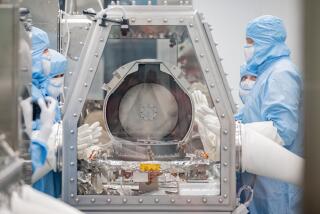TRAPPIST-1 planets are rocky and have complex atmospheres, new studies show
Could the TRAPPIST-1 star system host a life-friendly planet? Planetary scientists probing the bevy of small, Earth-sized worlds surrounding this not-too-distant star have found that at least a few may not look too different from our own.
The findings, described in a study in Nature Astronomy and a paper in Astronomy and Astrophysics, highlight the planetary system as a promising target in the search for life on other worlds.
Seven Earth-sized planets circle TRAPPIST-1, an ultracool dwarf star that lies about 40 light-years away. With about 9% of our sun’s mass, this star is very small and dim. That means that even though TRAPPIST-1’s planets lie so close to their star that they would sit within Mercury’s orbit around the sun, a number of them still could be the right temperature to hold water. And because they’re so close to their star, the planets circle it frequently, making them easier to study.
The system has drawn scientists’ attention since the discovery of its first two planets was reported in 2016. Keep in mind, an Earth-sized planet has a good chance of being rocky like our own. So TRAPPIST-1 presents a natural experiment: What happens to similar worlds at slightly different distances from the same star?
“It brings us seven different perspectives on planet formation and evolution around the same star,” said Julien de Wit, a planetary scientist at the Massachusetts Institute of Technology who led the Nature Astronomy paper and was a co-author on the Astronomy and Astrophysics study. “So it will be really fascinating when we get to dive into the atmosphere of each of these planets and see how different or similar they are.”
NASA’s powerful James Webb Space Telescope, set to launch in 2019, will be able to harness that natural experiment, searching the faint atmospheres for signs of molecules such as methane, water, oxygen and carbon dioxide — molecules that are significant for life.
But until then, scientists are trying to learn what they can with the telescopes they have. After all, just because these planets are smallish doesn’t mean they are actually rocky, or that they have atmospheres supporting liquid water or that they’ve got the right chemical balance for living things. The wrong atmospheric composition would make the possibility of life as we know it a non-starter.
An international team of scientists used the limited abilities of the telescopes at hand to chip away at those uncertainties. For the paper in Astronomy and Astrophysics, they used data from NASA’s Kepler and Spitzer space telescopes to accurately calculate the planets’ masses and densities.
Here’s how it works: A planet should cross in front of its star (from our point of view) at regular, predictable intervals — but it might be a little late or a little early, thanks to the gravitational tug from its fellow planets in the system. Those gravitational tugs then allow researchers to estimate the tugging planet’s mass. And combining the mass with the planet’s known size reveals its density, which scientists then use to figure out what materials it must be made of.
It’s painstaking work for a complex seven-planet system like TRAPPIST-1. But the researchers were able to determine the masses and densities with unprecedented accuracy, finding that the TRAPPIST-1 planets c and e probably have largely rocky interiors, and that b, d, f, g and h all must have a large “envelope” of volatile molecules, whether in the form of thick atmospheres, oceans or ice.
For the paper in Nature Astronomy, the scientists used NASA’s Hubble Space Telescope to probe the atmospheres of four of the planets in or near the star’s habitable zone — the area where water could potentially exist on a planet’s surface. They wanted to make sure these planets did not have puffy, hydrogen-rich atmospheres (rather like the gas giants in our own solar system). Hydrogen is a greenhouse gas, and such an atmosphere would make the planet far too hot for life. For three of those planets — d, e and f — that type of atmosphere was ruled out, which means they probably have atmospheres more like those on Venus, Earth or Mars. The jury is still out on planet g, the fourth planet that was studied.
“Basically, by ruling out this scenario, we’re ruling out a scenario that would have made the planet uninhabitable,” de Wit said of the planetary trio.
De Wit said the scientists are looking to study the thin atmospheric trails the TRAPPIST-1 planets’ atmospheres leave behind them as they move through space, rather like the ghostly tails of comets. The hope is that any hydrogen picked up in those planetary tails could come from the breakup of molecules from a large reservoir of methane or water. Water, of course, is essential to life as we know it, while methane can be eaten and produced by living things. Alone, neither is a guarantee of finding life, but they’re a promising step forward.
“So far, all the lights are green, so we’ll just keep on going — and we’ll see,” de Wit said. “It’s good to know that so far, so good.”
Follow @aminawrite on Twitter for more science news and “like” Los Angeles Times Science & Health on Facebook.
MORE IN SCIENCE
Galaxies that move together have cosmologists stumped about dark matter
Humanity will need to make some drastic changes if it wants to keep the ‘good life’ going
Radiation from cellphones is not hazardous to your health, government scientists say







